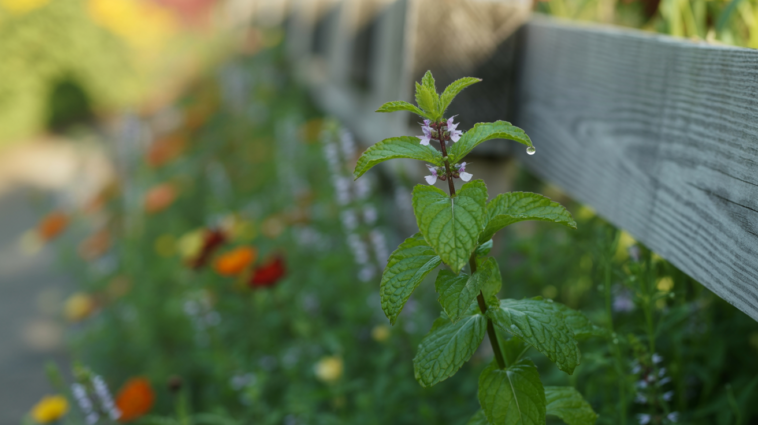If you’ve ever planted mint directly into your garden bed, you probably learned the hard way how fast it spreads. I sure did. One little transplant turned into a full-blown mint invasion by the end of the season! These days, I grow my mint in large pots or containers, sometimes even sinking the pots into garden beds to control the roots. It works beautifully—and it also opens the door to companion planting.
When mint is grown responsibly, it becomes a powerful ally in the garden. Its strong scent confuses pests, improves pollinator activity, and even helps neighboring plants thrive. Over the years, I’ve experimented with dozens of pairings. Some didn’t get along, but others turned out to be a match made in herb heaven. Here are 15 plants I’ve had real success growing with mint.
Cabbage
Cabbage—and really all the brassicas—can benefit from mint’s pest-repelling powers. Cabbage moths, aphids, and flea beetles all seem to dislike the scent of mint. I plant my cabbage in rows and place a few mint containers at the ends. The leaves stay fuller and less chewed up when mint is nearby.
Kale
Kale is another cool-season favorite that benefits from mint’s natural defense system. I’ve had less trouble with cabbage loopers and aphids when I surround my kale with mint pots. It also helps that they have similar moisture preferences, making watering easier.
Broccoli
Broccoli heads are a prized harvest for me, but they can attract some annoying pests. Mint helps deter whiteflies and flea beetles. I keep mint close, either in small sunken pots or nearby containers, and the broccoli seems happier for it.
Cauliflower
Much like its brassica cousins, cauliflower does better when pests are kept at bay—and mint helps make that happen. I’ve had fewer issues with leaf damage since growing cauliflower alongside mint.
Carrots
Carrot root flies are sneaky and destructive, but they don’t like strong-smelling plants. I place mint containers around my carrot rows and it really does seem to confuse the pests. Plus, the combo of feathery carrot tops and mint leaves makes the bed look lush and layered.
Tomatoes
Tomatoes love a bit of mint in their corner. I grow mint in pots near my tomato containers to help deter aphids and spider mites. As long as the mint doesn’t encroach on the tomatoes’ roots, they get along really well.
Peas
Sweet peas and snow peas both benefit from mint’s aphid-repelling scent. I train my peas up a trellis and keep a mint pot close by. It’s also handy to have mint nearby when I’m harvesting—one snip of peas, one snip of mint for my tea.
Beans
Beans—especially bush beans—pair well with mint, too. Just like with peas, I’ve noticed fewer aphids and fewer spider mites when mint is planted nearby. Just make sure it doesn’t get too cozy with the bean roots.
Beets
I never used to plant mint near my beets, but one year I gave it a shot—and now I always do. Mint helps reduce issues with leaf miners and leaf spot. Since beets are root vegetables and mint is usually in a container, they don’t compete much.
Lettuce
Lettuce is one of my favorite greens to grow, but slugs and aphids love it too. I find that mint helps reduce the slug population a bit, especially when I scatter mint leaves as a barrier. It’s not foolproof, but it helps, and the fresh smell in the lettuce bed is lovely.
Radishes
Radishes are quick to grow and don’t need much space. I usually tuck them around the base of my mint pots. Since radishes aren’t around for long, they don’t compete with the mint, and I’ve seen fewer flea beetles when mint is present.
Nasturtiums
Nasturtiums are great trap crops for aphids, but when I grow them near mint, it seems to keep aphid numbers lower overall. Plus, the bright flowers and green mint leaves look beautiful together. I love using them in salads side by side.
Marigolds
Marigolds are one of my go-to companions in the garden, and they work surprisingly well with mint. Both plants repel pests in different ways, and together they create a powerhouse of natural pest defense. I love pairing them in patio pots too.
Swiss Chard
Chard is such a reliable leafy green, and it benefits from a little mint nearby. I keep a couple of small mint pots next to my rainbow chard rows, and I’ve noticed less leaf damage. It’s an easy, low-maintenance pairing that adds flavor and color to the garden.
Onions
The strong scent of onions already repels pests, but mint adds another layer of protection. I plant them near each other, usually in alternating rows or with a container of mint at the center of an onion patch. It seems to help keep away onion flies and aphids.
Mint may have a wild streak, but when you plant it wisely—in containers, near the right crops—it becomes a gentle guardian for your garden. These pairings work not just because mint repels pests, but also because it brings in bees, deters mildew, and thrives in a wide range of growing conditions.
If you’re like me and love the idea of a more pest-resistant garden without resorting to sprays, give these companion plantings a try. Start small with a few pots of mint and move them around until you find the perfect spots. Before long, you’ll start to notice a real difference.
And trust me, harvesting fresh mint from the same space where you’re picking lettuce or tomatoes is a little joy that never gets old.


